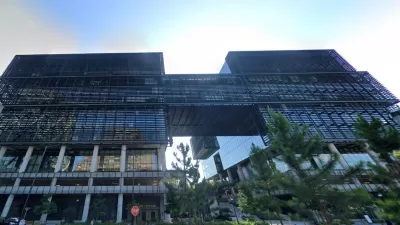Championed for over a decade, the LEED certification program has given notoriety to many newly constructed 'green' buildings, but new measures are helping us measure sustainability at the community scale, writes Kaid Benfield.
Since 1998, LEED (Leadership in Energy and Environmental Design) has provided planners, architects and citizens alike with an easy to understand scale to measure the sustainability of a newly constructed building. And their LEED-ND tool, which was developed with the help of Benfield's colleagues at the NRDC, is intended, "to do for multi-building, neighborhood-scale projects and for smart growth what the LEED systems had already done for individual green buildings."
Several new initiatives, however, have Benfield excited about the possibilities of measuring sustainability at a larger scale. Explained by Benfield, Rockford, Illinois and the State of New Jersey are developing their own system of indicators to measure their respective sustainability efforts. Rockford's Vital Signs initiative, "is designed as a system in which measurements are taken at multiple times throughout the 20-year planning horizon, in order to indicate progress and determine whether adjustments in strategy are necessary." Using indicators in 16 core categories, the tracking system is impressively extensive.
The other program described by Benfield, Sustainable Jersey, "includes a point-based rating system similar to those used in LEED, but at a community-wide scale approaching that of the Rockford initiative. Unlike either of those programs, however, Sustainable Jersey does not employ precise measurements to determine performance achievement but is aimed at a more conceptual and programmatic level."
FULL STORY: Measuring community sustainability: how do we know if we're on the right path?

Planetizen Federal Action Tracker
A weekly monitor of how Trump’s orders and actions are impacting planners and planning in America.

Maui's Vacation Rental Debate Turns Ugly
Verbal attacks, misinformation campaigns and fistfights plague a high-stakes debate to convert thousands of vacation rentals into long-term housing.

San Francisco Suspends Traffic Calming Amidst Record Deaths
Citing “a challenging fiscal landscape,” the city will cease the program on the heels of 42 traffic deaths, including 24 pedestrians.

Amtrak Rolls Out New Orleans to Alabama “Mardi Gras” Train
The new service will operate morning and evening departures between Mobile and New Orleans.

The Subversive Car-Free Guide to Trump's Great American Road Trip
Car-free ways to access Chicagoland’s best tourist attractions.

San Antonio and Austin are Fusing Into one Massive Megaregion
The region spanning the two central Texas cities is growing fast, posing challenges for local infrastructure and water supplies.
Urban Design for Planners 1: Software Tools
This six-course series explores essential urban design concepts using open source software and equips planners with the tools they need to participate fully in the urban design process.
Planning for Universal Design
Learn the tools for implementing Universal Design in planning regulations.
Heyer Gruel & Associates PA
JM Goldson LLC
Custer County Colorado
City of Camden Redevelopment Agency
City of Astoria
Transportation Research & Education Center (TREC) at Portland State University
Jefferson Parish Government
Camden Redevelopment Agency
City of Claremont




























